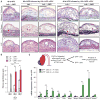Senescent intimal foam cells are deleterious at all stages of atherosclerosis
- PMID: 27789842
- PMCID: PMC5112585
- DOI: 10.1126/science.aaf6659
Senescent intimal foam cells are deleterious at all stages of atherosclerosis
Abstract
Advanced atherosclerotic lesions contain senescent cells, but the role of these cells in atherogenesis remains unclear. Using transgenic and pharmacological approaches to eliminate senescent cells in atherosclerosis-prone low-density lipoprotein receptor-deficient (Ldlr-/-) mice, we show that these cells are detrimental throughout disease pathogenesis. We find that foamy macrophages with senescence markers accumulate in the subendothelial space at the onset of atherosclerosis, where they drive pathology by increasing expression of key atherogenic and inflammatory cytokines and chemokines. In advanced lesions, senescent cells promote features of plaque instability, including elastic fiber degradation and fibrous cap thinning, by heightening metalloprotease production. Together, these results demonstrate that senescent cells are key drivers of atheroma formation and maturation and suggest that selective clearance of these cells by senolytic agents holds promise for the treatment of atherosclerosis.
Copyright © 2016, American Association for the Advancement of Science.
Figures




Comment in
-
Basic research: Killing the old: cell senescence in atherosclerosis.Nat Rev Cardiol. 2016 Dec 12;14(1):8-9. doi: 10.1038/nrcardio.2016.195. Nat Rev Cardiol. 2016. PMID: 27941859 No abstract available.
-
Assisted Living in the Atheroma: Elderly Macrophages Promote Plaques.Cell Metab. 2016 Dec 13;24(6):779-781. doi: 10.1016/j.cmet.2016.11.013. Cell Metab. 2016. PMID: 27974178
References
Publication types
MeSH terms
Substances
Grants and funding
LinkOut - more resources
Full Text Sources
Other Literature Sources
Medical
Molecular Biology Databases
Miscellaneous

